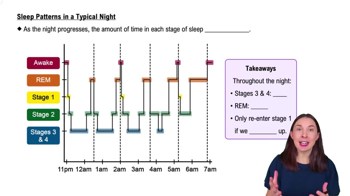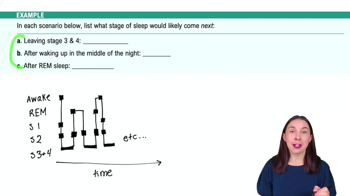Table of contents
- 1. Introduction to Psychology1h 43m
- 2. Psychology Research2h 20m
- 3. Biological Psychology2h 41m
- 4. Sensation and Perception28m
- 5. Consciousness and Sleep32m
- 6. Learning41m
- 7. Memory34m
- 8. Cognition37m
- 9. Emotion and Motivation35m
- 10. Developmental Psychology33m
- 11. Personality48m
- 12. Social Psychology41m
- 13. Stress and Health41m
- 14. Psychological Disorders44m
- 15. Treatment47m
5. Consciousness and Sleep
Sleep
Struggling with Psychology?
Join thousands of students who trust us to help them ace their exams!Watch the first videoMultiple Choice
Debbie's psychoanalyst tells her that the monster in her dream symbolizes her abusive father. He is discussing the dream's
A
manifest content.
B
actual content.
C
latent content.
D
spiritual context.
 Verified step by step guidance
Verified step by step guidance1
Understand the concept of 'latent content' in psychoanalysis, which refers to the hidden psychological meaning of a dream, as opposed to the 'manifest content,' which is the literal storyline of the dream.
Recognize that in psychoanalysis, dreams are often interpreted to uncover unconscious desires or thoughts. The latent content is what the dream truly represents beneath its surface.
Identify that the psychoanalyst is interpreting the dream by suggesting that the monster symbolizes Debbie's abusive father, which is an example of uncovering latent content.
Differentiate between the terms: 'manifest content' (the actual events of the dream), 'latent content' (the symbolic meaning), and 'spiritual context' (which is not typically used in psychoanalytic dream interpretation).
Conclude that the psychoanalyst is discussing the latent content of Debbie's dream, as he is interpreting the underlying meaning rather than the dream's literal events.

 3:25m
3:25mWatch next
Master Circadian Rhythms with a bite sized video explanation from Hannah Gordils
Start learningRelated Videos
Related Practice


































































































![Race, Genes and IQ Differences | Bret Weinstein [Mini Clip]](https://img.youtube.com/vi/IztL_m3pd70/mqdefault.jpg)



































































































